Weddings Of India(temp)
- Abdullah
- Jan, 02, 2022
- All
- No Comments
India spans hundreds of cultures and is spread across varied terrain. As such the people living in this country have very distinct cultures and traditions of their own.
This is evident from the wedding ceremonies of the different cultures that inhabit India.
Indian weddings feature some of the most vibrant ceremonies that fascinate people the world over. Read to learn about the wedding traditions of India.
In this article, we will be going over the unique ceremonies of the major cultural groups that live in India. You will be able to get a much better understanding of what goes on in an Indian wedding.
Let’s start off by listing the major cultural groups that reside in India.
- Hindus
- Muslims
- Sikhs
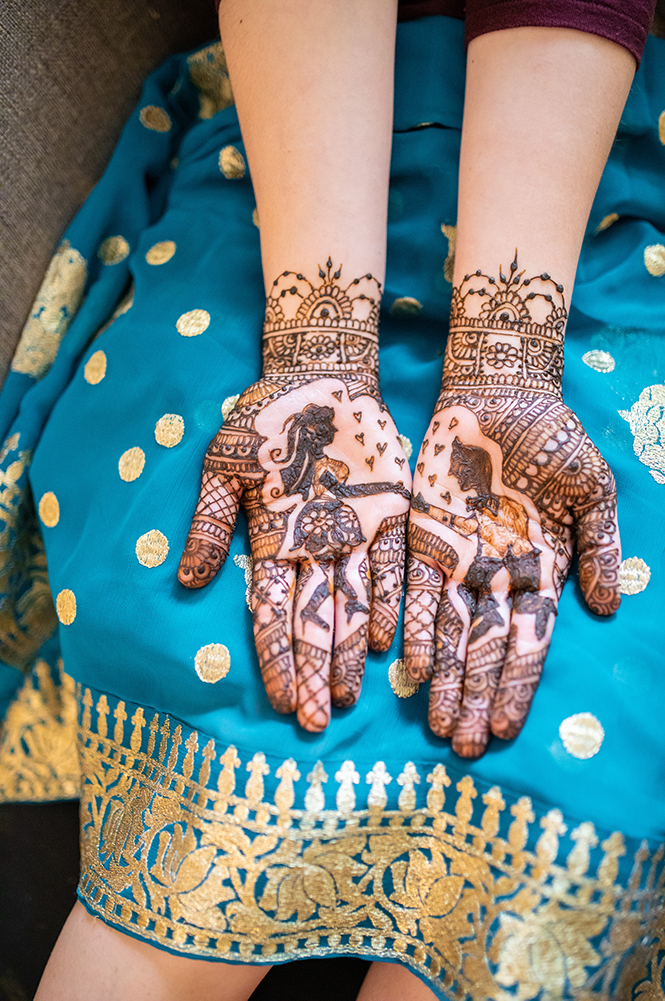
Hindu Weddings
Hindus form the majority of the Indian population, making up almost 80% of the total population. There are major cultural differences in how people of a certain region get married, even if they are of the same religion.
Some regions have developed different customs and traditions over time and as a result have become completely unique. However, there are a few key elements that are found in all Hindu weddings, no matter the region.
Namely, these are:
- Kanyadan
- Panigrahna
- Saptapadi
Kanyadan
Kanyadan is a tradition in which the Bride’s family accepts the Groom as their son-in-law. It is also thought of as a tradition in which the Bride’s father gives away his daughter into her new home.
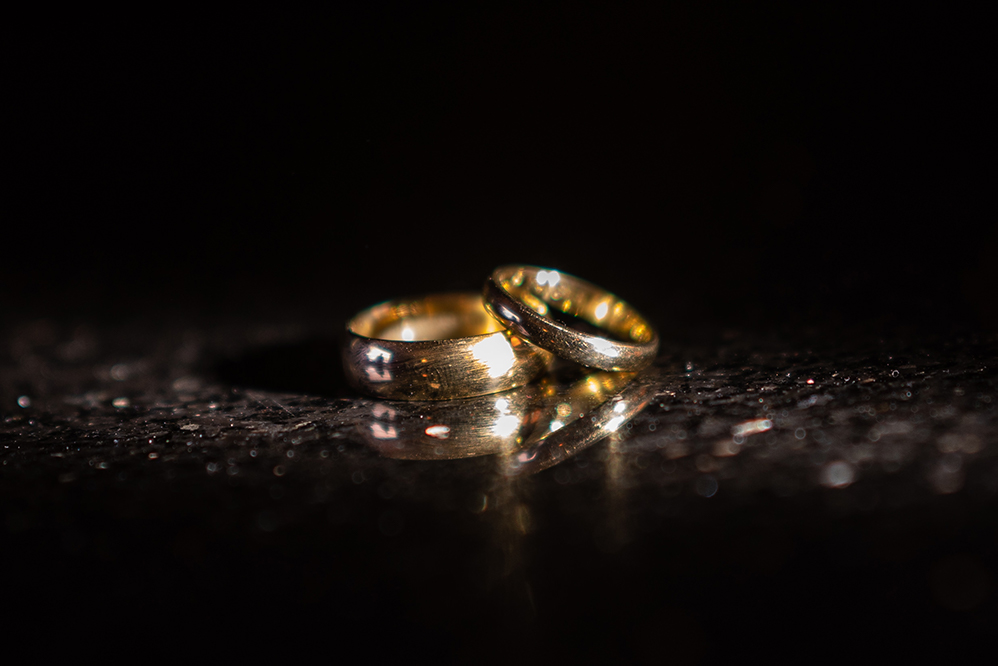
Kanyadan is a Hindu wedding ritual that holds a lot of importance in Hindu weddings throughout India.
As with all wedding rituals, different cultures across India have added their unique touches to the ritual, but the core purpose remains the same throughout the different regions.
Panigrahna
This ritual, also known as the “Holding Hand” ritual is an important tenant of a Hindu wedding.
The bride and groom both hold each other’s right hand and the groom announces his acceptance of his responsibilities to the bride.
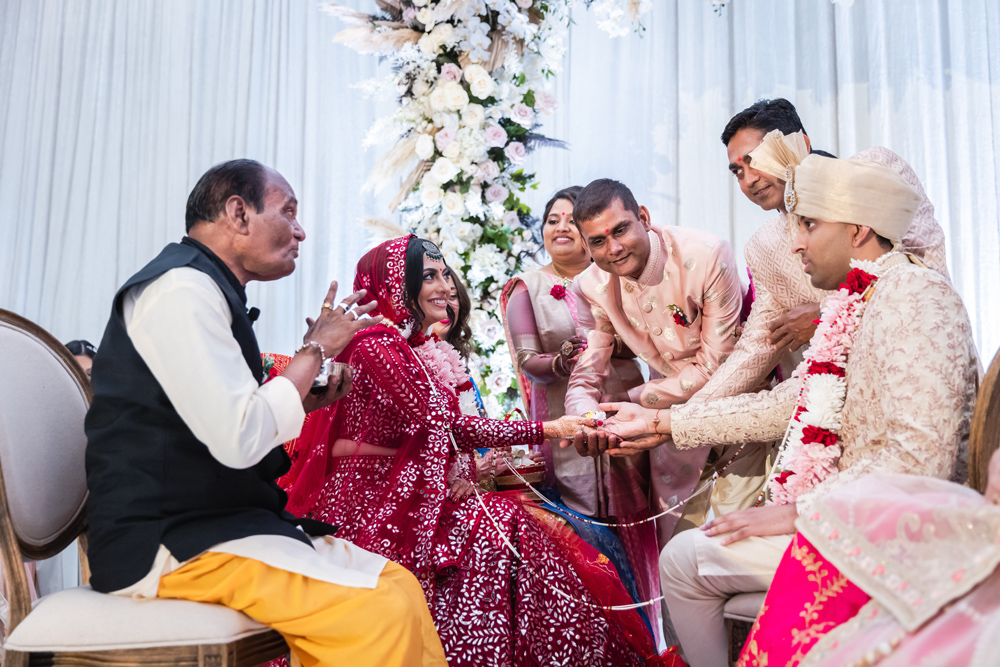
In most cultures, a symbolic fire is lit before the bride and groom while this ritual takes place, but in South Indian weddings this is not observed.
Saptapadi
Saptapadi literally translates to “seven steps”. In this iconic ritual, the bride and groom walk seven circles around a fire. Each circle represents the promises that they have made to each other.
The bride and groom tie their dupattas with each other, which is supposed to symbolise unity.
The groom leads the bride for the first four circles, or “pheras” and then the bride leads the last three.
The seven promises made by the couple are as follows:
- Let us take care of our families, stay well, and fulfil our obligations and responsibilities to each other, our families, and our traditions.
- Let us strengthen our mental and spiritual abilities.
- Let us use righteous and proper measures to expand our wealth and comfort.
- Through mutual love, respect, and trust, let us gain knowledge, happiness, and harmony.
- May we be blessed with a large family of strong, virtuous, and heroic offspring;
- May we live long lives
- May we remain loyal companions, solely committed to each other.
Muslim Weddings
As compared to Hindu weddings, Muslim weddings around India are not too different from one another in the different regions of India.
In Muslim weddings, there are 4 major ceremonies that take place and are considered to be the core of the wedding, let’s take a look at each of them.
Mangni
The official engagement ceremony between the bride and groom, as well as their respective families, is known as Mangni. On a predetermined day, close friends and family from both sides assemble to witness the bride and groom exchange rings.

Each family gives each other sweets, fruits, dry fruits, clothes, and sometimes money as gifts. The bride and groom are regarded betrothed to each other in the eyes of society after this ritual, which officially seals the intention of marriage between the two families.
Mehendi
Muslim brides in India and Pakistan follow an intricate Mehendi rite utilising henna paste. The evening before the wedding, the women of the family gather around the bride in a women-centric gathering.
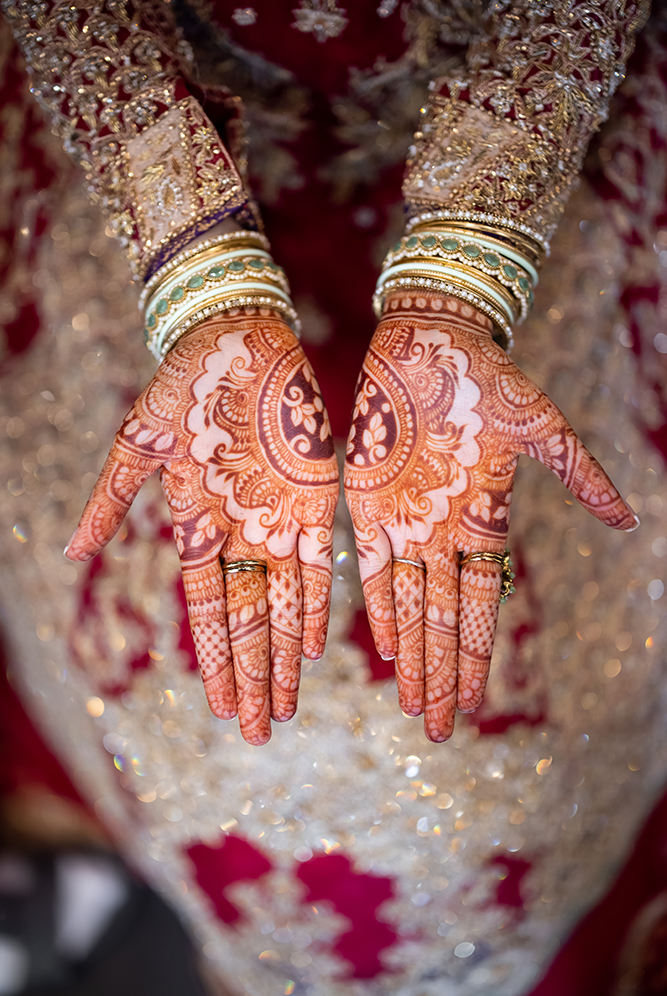
The responsibility of painting henna paste in unique, complex designs on the bride’s hands and feet is left to the family’s most artistic lady. Professional Mehendi artists are now employed to perform the task.
The groom’s initials are usually included in the bride’s henna decorations, which he must discover on their first night together. Henna is also applied to the hands of the family’s female members.
Baraat
For the Baraat, the groom leaves his house with considerable pomp and circumstance, accompanied by a large number of his close friends and relatives.
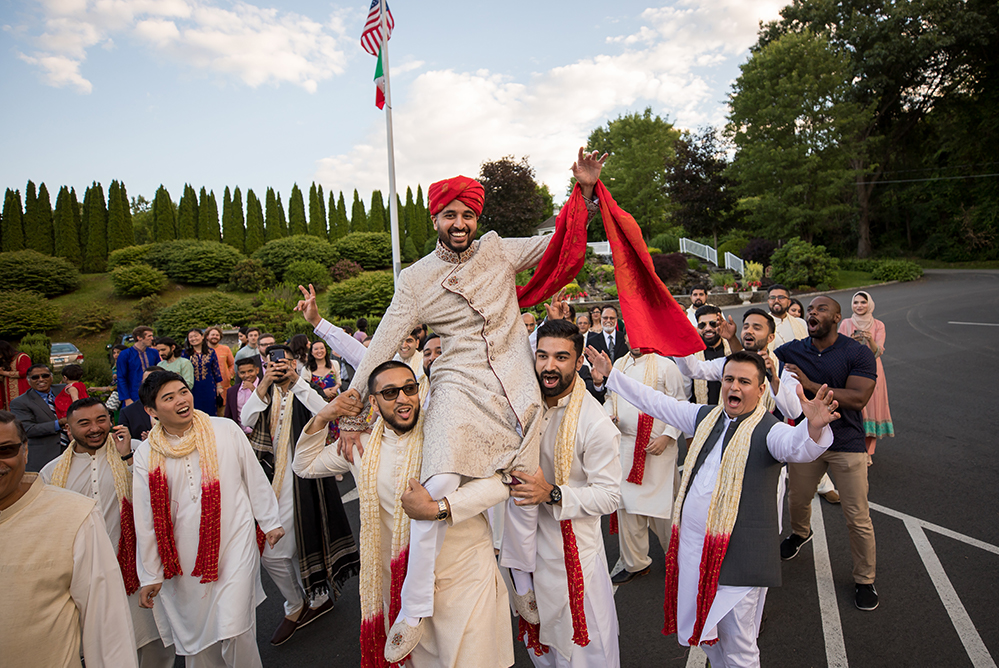
The bride’s family usually sends a lavishly adorned car to transport the groom. A member of the bride’s family visits the groom at his home and essentially escorts him to the wedding destination.
The Baraat is the name given to the wedding party as it travels towards the wedding destination, followed by the groom’s relatives.
Nikah
A religious priest or Maulvi performs the wedding or Nikah ceremony. For the ritual, men and women are seated in separate groups. The women usually cluster around the bride, while the males congregate around the groom.
The Maulvi appoints the bride’s father as Wali, or guardian, to watch after the bride’s interest in the Nikah. The groom’s family gives the bride Mehr, which is a pre-determined amount of money, in exchange for her permission to marry the groom.
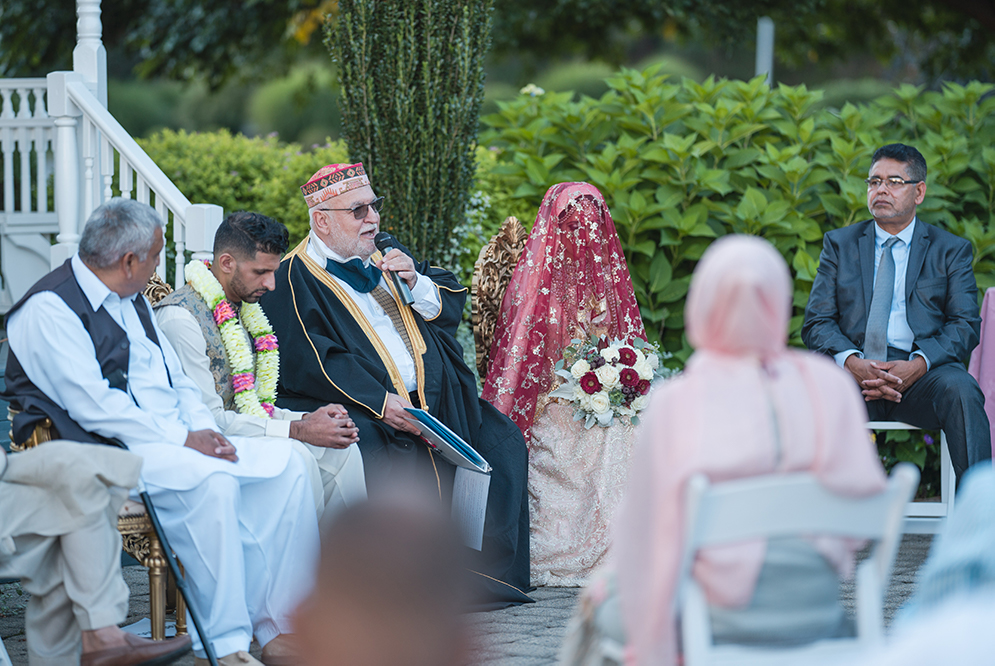
The Maulvi begins the Nikah ceremony by reciting a prayer from the Quran. The bride is then asked if she agrees to marry the groom by accepting the Mehr. This is where he asks the bride three times in succession, ‘Qubool Hain?’ (Do you give your consent). The bride must respond with an emphatic “Qubool Hain.”
The Maulvi then proceeds to the groom and repeats the process. Ijab-e-Qubool is the name given to this ceremony. The bride and groom must be separated from one another so that they cannot see each other.
Following the Ijab-e-Qubool, the Nikahnama, or marriage contract, is signed. The Nikahnama lays forth all of the bride’s and groom’s responsibilities and rites as prescribed by the Quran.
Both the groom and the bride must sign in front of at least two witnesses from each side. The recital of the Khutba, a religious speech, follows. The Maulvi then recites verses from the Holy Quran that are akin to wedding vows.
The bride and groom do not need to repeat their vows, but they should pay attention to them. The vows are followed by duruds, in which the family’s elders bestow their blessings on the newlyweds.
Sikh Weddings
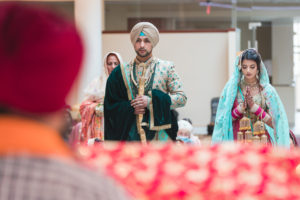
There are about 21 million Sikhs living in India, mostly concentrated in the northeastern region of the country. While about 85% of Sikhs in the world live in India, they make up only about 1.7% of the Indian population.
Given the fact that the Sikh population in India lives in the North East, there are not a lot of differences between the marriage ceremonies followed by the people.
Let’s take a look at the different marriage ceremonies that are followed by the Sikhs.
Roka/ Thaka
All Sikh weddings require the agreement of parents from both sides, whether it is an arranged marriage or a love marriage.
The bride’s father usually pays a visit to the groom with a few members of his family to demonstrate his approval by applying a tilak to the groom’s forehead and bringing him presents of sweets and garments, as well as a kara or ring.
The groom’s father also repeats the same gesture by visiting the bride’s family.
Chunni
The groom, his relatives, and close friends present the bride with an auspicious red attire, jewellery, a small chunni, and makeup to wear on the wedding day. The bride is traditionally given her clothing and accessories by a female relative.
They would take her to a separate room and dress her in the appropriate attire and accessories before bringing her back to the assembly and seating her next to the groom.
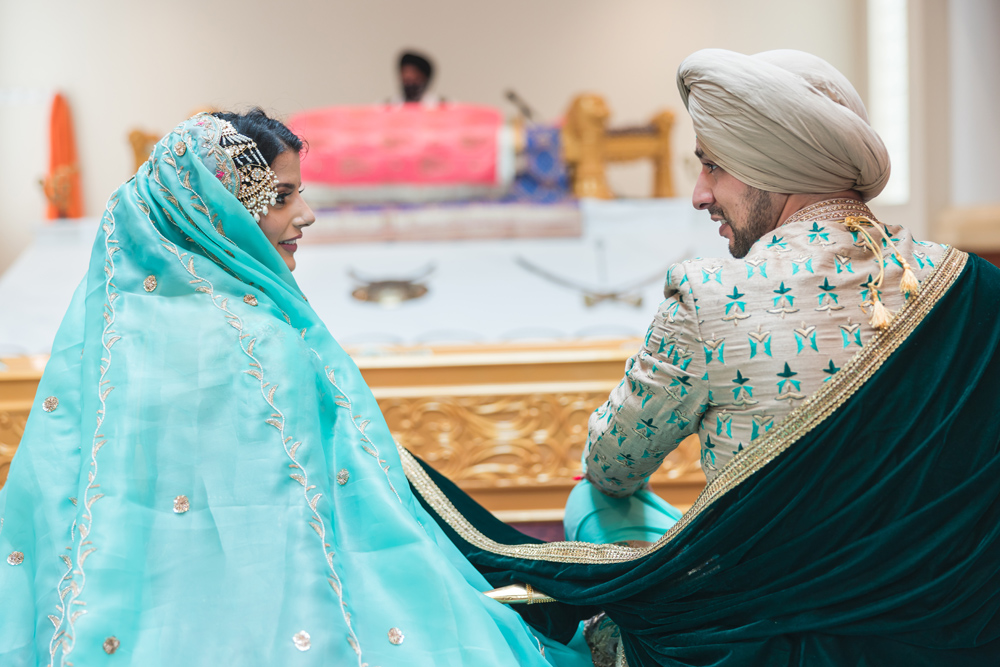
The bride’s mother would next drape a simple crimson chunni over her head and shoulders, apply mehndi to the palms of her hands, and give her Indian sweets.
Sangeet
This is a significant occasion in Sikh and Punjabi culture. Singing Punjabi folk songs is a technique of storytelling that has been passed down through the years. Weddings are marked by the singing of Punjabi folk music and the dancing of the newlyweds.

Originally, sangeet was a ladies-only occasion, but as time passed, the tradition evolved. Men are now participating in this event in order to enjoy an updated form of singing and dancing to DJ music. This event is typically held in a ballroom that is selected to accommodate the number of visitors expected, with dinner served at the conclusion.
Baraat
Similar to Muslim weddings in India, the Sikhs also have the tradition of Baraat, where the groom’s family travels to the bride’s house for the wedding.
The baraat wedding party is traditionally made up of the groom’s relatives who travel to the bride’s home for the wedding.
The bride usually returned home with the groom after the wedding, who lived with his parents’ brothers and other paternal relations, such as uncles who were brothers of the groom’s father and their father, and so on.
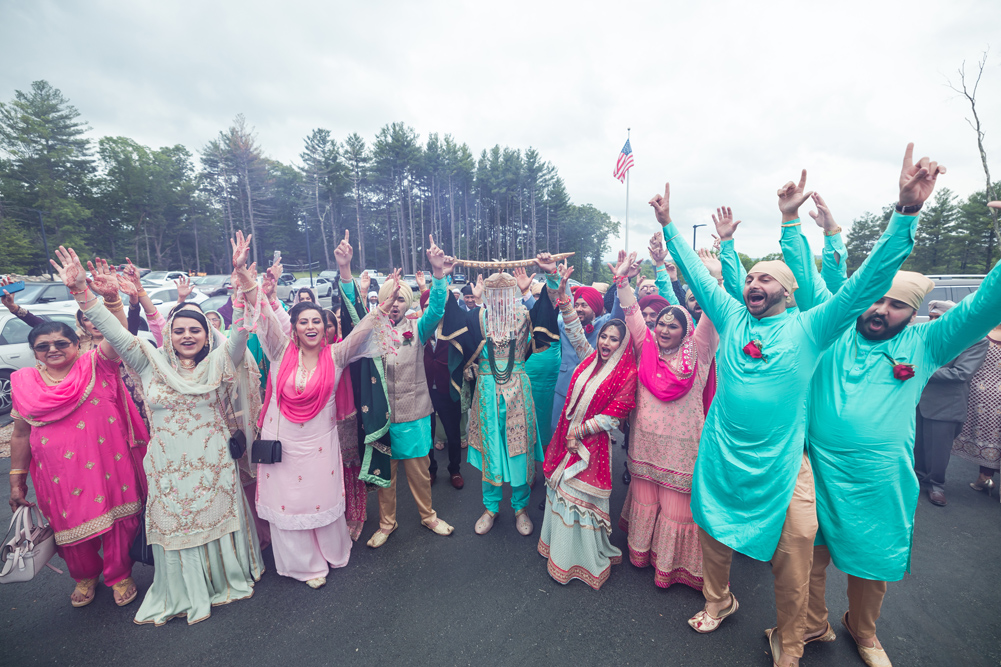
In modern times, the baraat may visit the bride’s home or simply gather outside the gurdwara wedding hall, where the bride and groom’s family exchange greetings before the Anand Karaj wedding ritual begins.
The distance travelled and if the wedding ceremony is modest, ornate, or opulent are all factors to consider.
